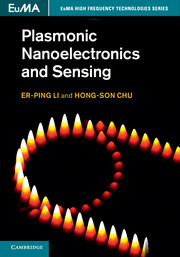Book contents
- Frontmatter
- Contents
- List of contributors
- Preface
- 1 Fundamentals of plasmonics
- 2 Plasmonic properties of metal nanostructures
- 3 Frequency-domain methods for modeling plasmonics
- 4 Time-domain simulation for plasmonic devices
- 5 Passive plasmonic waveguide-based devices
- 6 Silicon-based active plasmonic devices for on-chip integration
- 7 Plasmonic biosensing devices and systems
- Index
- References
6 - Silicon-based active plasmonic devices for on-chip integration
Published online by Cambridge University Press: 05 March 2014
- Frontmatter
- Contents
- List of contributors
- Preface
- 1 Fundamentals of plasmonics
- 2 Plasmonic properties of metal nanostructures
- 3 Frequency-domain methods for modeling plasmonics
- 4 Time-domain simulation for plasmonic devices
- 5 Passive plasmonic waveguide-based devices
- 6 Silicon-based active plasmonic devices for on-chip integration
- 7 Plasmonic biosensing devices and systems
- Index
- References
Summary
Photonic devices integrated in Si optoelectronic circuits offer less power dissipation and larger bandwidth than those of electronic components, but suffer from a larger footprint due to the fundamental diffraction limit of light in dielectric waveguides and the weak optical response of Si. These two limitations may be overcome by utilizing plasmonics owing to the tight optical mode confinement in plasmonic waveguides. Besides the capability of miniaturization of photonic devices on the nanometer scale, plasmonics also provides the potential to design novel photonic devices due to the incorporation of metal and dielectrics. In this chapter, we present Si-based active plasmonic devices developed in our laboratory, including modulators and detectors. These active plasmonic devices can be seamlessly integrated into existing Si optoelectronic circuits using standard CMOS technology.
Introduction
Silicon photonics, in which photonic devices are fabricated on silicon-on-insulator (SOI) platforms using mature CMOS technology, has been well developed recently for high-performance Si electronic-photonic integration circuits (EPICs) [1]. In particular, integrated Si modulators and Ge-on-Si detectors with performances competitive with those of their counterparts based on III–V semiconductors have been demonstrated [2, 3]. However, due to the fundamental diffractive limit of light in dielectric waveguides as well as the weak optical response of Si, the Si photonic devices suffer from large footprints. For example, Mach–Zehnder-based Si modulators, which are mostly implemented in Si EPICs, require a millimeter–scale length to reach π phase shift.
- Type
- Chapter
- Information
- Plasmonic Nanoelectronics and Sensing , pp. 180 - 216Publisher: Cambridge University PressPrint publication year: 2014



